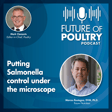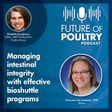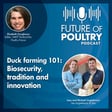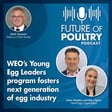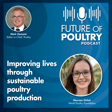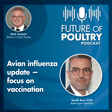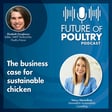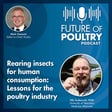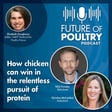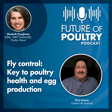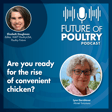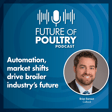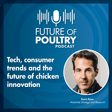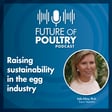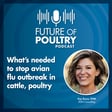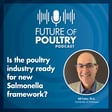Become a Creator today!Start creating today - Share your story with the world!
Start for free
00:00:00
00:00:01

Can you measure poultry welfare at the processing plant?
Evaluation of broiler carcasses after evisceration can provide insights into bird welfare from the hatchery all the way to the processing plant. Discover how in this edition of Future of Poultry Podcast, featuring Paco Fernandez Lopez-Brea, DVM, international business development, poultry, with Zinpro.
Transcript
Introduction and Welcome
00:00:00
Speaker
Hello and welcome to the Future of Poultry podcast series.
00:00:12
Speaker
My name is Terrence O'Keefe, and I'm the content director at WAC Global Media, and I'll be your host today. I attended the Poultry and Welfare Sustainability Summit, which is co-hosted by the U.S. Roundtable for Sustainable Poultry and Eggs in an international poultry welfare alliance recently.
Field Trip to University of Georgia
00:00:31
Speaker
On the first day of the summit, the University of Georgia's poultry science department hosted attendees for a field trip to the department's new building in Athens, Georgia.
Perfect Carcass Tool Demonstration
00:00:42
Speaker
One of the presentations that day was a demonstration of a system for evaluating broiler carcasses called the perfect carcass tool.
00:00:51
Speaker
Dr. Paco Fernandez is a veterinarian who works for ZenPro and he gave the demonstration and he has been kind enough to join us today to explain how the tool can be used to help integrators to determine the source of defects and work on improving the welfare of the birds and bottom line performance. Welcome Paco and thanks for joining us today.
00:01:16
Speaker
Thank you very much. Paco, I used to work in a turkey plant that sold a lot of graded products. And we used a system for evaluating carcasses while they were still on the picking line to help us look at, you know, determine where we thought injuries took place based on the color of the bruises or, you know, what a broken wing looked like. But the perfect carcass tool goes a lot deeper than that.
00:01:42
Speaker
Could you talk to us about the demonstration you gave and what the types of things that you're looking for? Yeah, this session was ah including the connection of our program with the welfare systems because it was all organized by the International Portrait Welfare Alliance. In fact, what we do is the first time we visit an integration we go to the end of the chain, not to the beginning, and just checking the processing plant, the carcasses, we try to determine how was the life of these birds going as back as the hatchery. So we can identify problems that happened during the processing, the transition from the farm to the slaughterhouse, problems at the farm level, and even in the incubation period. And when do that, we call that a forensic approach.
00:02:32
Speaker
We try to determine in each plant which are the main priorities, which are the costs inherent to these priorities, and what are the reasons causing these problems.
Micromineral Complexes and Poultry Health
00:02:44
Speaker
and We are considering all internal and external lesions, but we also take consideration of the fasting period and the last 24 hours of life of the chicken, which are the most stressing of them all.
00:03:00
Speaker
So once we have identified the reasons and the priorities, we find out in which part of the process they happen. And we try to dig in, go into these specific points of the process to see how we can minimize the problems and reduce the costs. So we set up action on plans that we can follow up to see after three, four months if we are going in the right direction or not.
00:03:26
Speaker
And if not, we can take corrective actions. In these actions, obviously, our interest is to show the activity of our micromineral complexes. As simple, we work with complexes of zinc, copper, manganese, iron, selenium and chromium.
00:03:44
Speaker
And we know that our micro-mineras are much more bioavailable than the rest of the sources. And by being more bioavailable, that means that they have more powerful effects. And the best way to measure these effects is going to the processing plant. So this was, in principle, the main reason why we were interested in going to the processing plant.
Challenges in Identifying Internal Defects
00:04:03
Speaker
Also, some of our customers told us that everything we could do to help them at the slaughterhouse level was going to be highly beneficial because in many cases they live a little bit isolated from the rest of the world and they don't even know if they are doing better or worse. So this was what the program is all about.
00:04:21
Speaker
Yeah, I was really impressed when you were doing what I kind of think of as a post-mortem of the carcass, except that these were healthy birds that came into the plant alive and were you know humanely slaughtered. But then I was surprised at some of the internal defects that were in the birds, particularly a lot of femoral head necrosis. Can you talk a little bit about that?
00:04:49
Speaker
many people when we explain to them what we do they say we already have video camera systems so we have already something doing we are doing something in the plant But the the problem is that these video camera systems do not identify the most important problems, which are the internal lesions. And when I talk about internal lesions, I'm referring to the myopathies, such as spaghetti meat, ah wooden breasts, white striping, green muscle, but also to one
00:05:20
Speaker
Very obvious problem in the farm, which is lameness. And lameness is manifested in lesions that have to do with the BCO, which stands for bacterial chondronicrosis with osteomalitis. It's what is usually known as femoral hand necrosis, but it doesn't only happen at the femoral level, but also happens in the tibia.
00:05:42
Speaker
and even in ah one of the thoracic vertebra. So this problem, the BCO, is the reason for 60% of the lameness in the world, in boilers, but also affects the turkeys and other avian species. For this problem to happen, we need two factors.
00:05:59
Speaker
The first factor is stress that will favor the translocation of bacteria from the intestinal lumen and from the respiratory tract. During these stressful periods they will be able to go through the epithelial barrier and to go into the blood. And from the blood they will find a way to the long bones where they will induce an inflammatory reaction that will end up in the BCO clinical science, which is basically lameness. The second factor, apart from this bacterial translocation that I remind is coming from the stress, the second factor is mechanical pressure. And it happens that epiphysis level in the long bones
00:06:46
Speaker
There are weak points due to the bad interconnection of blood vessels and connective tissue, and that makes these surfaces a little bit weak. When the animal gets heavy enough after day 35, for example, they develop a big breast, especially the new genetics, rosso eight ROS ROS-708, CO-500, etc.,
00:07:09
Speaker
When they develop a big breast, they increase enormously this mechanical pressure on these long bones joints. And then we will have this inflammatory reaction that will start by the formation of microfractures. And these microfractures will then be colonized by this bacteria coming from blood. So in the lesions, we can isolate bacteria that are coming from the intestine.
00:07:36
Speaker
such as Enterococcus ecorum, even E. coli, even Salmonella, but also some bacteria typically coming from the respiratory tract, like for example Staph aureus or even Streptococcus anetis, among others.
00:07:52
Speaker
And usually there is not a single type of bacteria but many different strains living happily together. ah came And they are over there a little bit isolated from the immune system and also the antibiotic treatments are not easily reaching them. So this is a perfect place to develop an inflammatory reaction.
Post-Mortem Evaluations and Farm-Level Insights
00:08:14
Speaker
I find this whole approach fascinating because as I said, i'm I'm used to a system where we're looking at external lesions and that did help us track down, okay, this catching crew maybe was a little rougher than the other crews or we had a problem with the stunner.
00:08:35
Speaker
When the shift started the birds were cold when they came in so you know the stunning and the Picking didn't quite work the way we normally would expect and we got a lot of benefit from that type of the system But this is really fascinating when you're collecting information on the internal you know what's going on inside the bird throughout its life and It allows you to try and take that data and go back in other parts of the chain. so Can you give us some examples of what your clients have been able to do with some of this data? Of course, the first point is to identify if this problem is happening pre-mortem or post-mortem. For example, if we are talking about Bruces and Hematomas.
00:09:22
Speaker
You have to pay attention to the extension of the matoma because if the heart was pumping so the animal was alive, it's going to be larger. We have to pay attention to the color because if it's very fresh, it's going to be pinkish.
00:09:37
Speaker
but then it starts getting darker and bluish finally it gets green after two days and after three four days it ah it is transformed into yellowish and finally it can come back to normality if we would give the bird time enough to resolve the problem but also we have to pay attention to the clotting if there is clotting in the emma toma so it's a good idea to cut and to see what is inside Then we can estimate that this lesion is not coming from the plant, but it's coming from the farm. Because clotting in the birds takes about one hour to happen. It's much slower than in humans. In humans after one to five deep minutes, you get the clotting, the coagulation, and the wound is closed. But in chicken it takes longer. The reason that thromboplastin, which is the protein that starts this process, is not in the blood in the serum, but it's in the tissues.
00:10:32
Speaker
So it takes a little bit longer to release this thromboplastin to start the process. So by checking the extension, the color and the plotting, we can determine if the problem is coming from the farm, from the transition or from the plant. And therefore the next point is, okay, in which exact point is this happening? And then we have to log to go and look for that.
00:10:54
Speaker
So this is just, for example, talking about the the bruises. But the bruises will tell us a lot of things about the timing of the lesion. Also, if we talk about myopathies, for example, there is a very nasty myopathy called the green muscle, or the pectoral myopathy, if you prefer. If you see the tender of the chicken in the breast, so the pectoralis minor, which is greenish, is not the normal color, but is completely green,
00:11:23
Speaker
This is happening at least two or three days before the death. And it's typical in these fabs that are conducting thinning. And this is very common in Europe, for example. And this happens because when the animals are flopping, this muscle doesn't have the space to expand.
00:11:41
Speaker
because it's constrained between the sternum and the pectoralis major. And therefore there is a hypoxic development that ends up with a necrotic tissue that becomes green after two or three days.
Evaluating Poultry Welfare at Processing Plants
00:11:52
Speaker
So this is how we can determine where and when and how the problems happen.
00:11:58
Speaker
These are just two examples. Of course, if you see BCO that we were talking about before, you see you can determine that there was a certain level of lameness in the fab. Usually, we can differentiate the lesions between mild and severe.
00:12:15
Speaker
If the lesions of femoral hand necrosis, for example, are severe, I estimate that about half of them will transform into lame animals in the fall. So if we have 8% of BCO severe in the femur, I could probably tell to the veterinarians, are you abbi are you having problems of lameness in the fall?
00:12:36
Speaker
And I suppose you have about three, four percent of the best lane. Is that right or not? And usually they can confirm or not. And if they are not confirming, then I have to try to understand why this is happening. OK, so it's a kind of a detective activity sometimes, but it makes all of that much more interesting. I really learn every time I do an inspection and evaluation, I learn something new.
00:13:03
Speaker
I can tell you if the scalding temperature was very high or very cold. I can tell you if the pressures of the placards or the pickers, as you say in the US, was too hard or not. I can even tell you if the hatchery was overcooking the embryos or not. I can tell you if there was a heterococcus problem with the hatchery or not.
Anonymous Data Submission and Global Comparisons
00:13:23
Speaker
So I can say a lot of things about the previous life of the birds, even reaching the hatchery.
00:13:31
Speaker
I can tell you if yeah if I see, for example, a very high level of BCO, I can almost guarantee you that these birds were on a non-antibiotic diet. Because in these countries in which, for example, still is allowed the utilization of antibiotic growth from promoters, then I see half the level of BCO than I see in the countries that are antibiotic free.
00:13:57
Speaker
So these are just a few examples. I could go on and on with different lesions, but this is basically how we work. It's fascinating hearing you describe the ability to take this snapshot, so to speak, when you do the post-mortem on the carcass and relate that to the life of the bird. Because one of the things that, you know, an idea I get in my head after that is this could be a measure of here's the welfare of the birds coming through your system. You know, because a lot of times, you know, we've talked about
00:14:35
Speaker
yeah the potential for cameras on farms and other measurements on farms for welfare. But there's a challenge because we have so many houses and so many farms. But if you could do that kind of evaluation per flock in the processing plant, then suddenly it sounds like you know it would be possible to you know have some kind of a ah report on each flock that comes in.
00:15:04
Speaker
Absolutely. I can tell you that checking the welfare issues at the plant has many, many advantages. Just to mention a few ones. First, it's faster than doing it in the farm. Second, it's more reliable. The carcasses don't lie. They tell you the truth if you know how to interpret what you see.
00:15:30
Speaker
The third point is that when you conduct this exercise, you are not stressing the birds. They are not alive. There is no risk of infection. You don't have to go to the farms. Imagine if you go to a farm to check welfare, and just five or seven days after, there is an outbreak of avian influenza, for example. That would not be nice to you, okay?
00:15:53
Speaker
And finally, we are not missing the most stressful period of the life of the bird, which is the last 12 hours. Since the animals are harvested at the farm level until they are loaded into the truck, transported to the plant, and waiting, shackling, until they are stunned, this is the most so stressful period for many reasons.
00:16:16
Speaker
including the fact that they don't have any more access to the feet or to the water. And usually in the welfare system that we do at the farm level, we are not taking into account this stressful period. So these are several of the reasons why I consider that welfare should be better evaluated even at the processing plot level.
00:16:41
Speaker
One other advantage that we haven't really talked about yet is that for companies participating using this system, they're kind of submitting their data anonymously, and then they can see how they compare with other complexes. Is that correct?
00:16:59
Speaker
Yeah, absolutely. We started this program about 10 years ago. And now we have data coming from 39 different countries and more than 200 different companies. So we have data coming from all types of production of broilers. We have data with the kosher system from Israel.
00:17:21
Speaker
We have data from the halal without stunning that is conducted, for example, in Saudi Arabia, in the Gulf of States. We have data from halal with stunning, which is what most of the Arab countries are doing, Morocco, Egypt, etc. We have data with stunning by gas. We have data with stunning with electricity.
00:17:45
Speaker
and inside electricity systems we can differentiate the european method in which we have by law to kill the birds with the electrocution and the american system in which we use a low voltage and high frequency by doing that we are causing much less problems that with the european system so we can compare them and i can tell you which are Predicted lesions that we are going to see in each one of these different staining systems, for example. And the same that I am talking about stanners, I can be talking about different scalding systems, different ah types of placards, different types of chillers. So every region is doing different things. But the good thing or the positive thing for us is that most of the world is using the same two genetics.
00:18:42
Speaker
and so the problems are most of the time are very similar. The only thing that changes is the frequency and the intensity of the problems due to different equipment, different types of studying or even different weights because also the weight of the birds when they are sacrificed is completely different.
00:19:06
Speaker
You can have a small birds, for example, in Saudi Arabia, 1.5, 1.6 kilograms body weight. And you can find in the US big males with 4.5 kilograms average. That means that some of them are more than 5 kilograms. So it's completely different types of lesions that you will find in any small bird or any big big but pick bird.
00:19:29
Speaker
And even we can go deeper than that by telling you that males and females behave completely different. And it was interesting because I had a customer during my stay in the US that asked me if the females had more fractures, for example, than the males. And to be honest, at the time I haven't paid attention to that, but the truth is that after digging into the literature and in the in the numbers that we have, we found out that it's true. The females, for example, have more fractures than the males because they have poorer skeleton robustness. They have more difficulties to produce collagen and to have the right organic matrix, but also they have a lower level of mineralization of the bones.
00:20:18
Speaker
So even at the same age, they are more prone to have more fractures than the males. These are just specific examples. Interesting on the males and females. Now, was this data that you're referring to from complexes where they raise the sexes separately or were the yeah males and females in the same house, but you can tell which were the males and which were the females because you're doing the the posting?
00:20:46
Speaker
Yeah, usually it's relatively easy to differentiate a male and a female because, okay, in the male you can see the testes and the amount of fat is different. The female has more fat. The size of the birds is completely different as well. Even the diameter of the shanks in the feet are different.
Sexing Broilers for Automation Benefits
00:21:08
Speaker
But if you ask me about the future, I think that the future will be sexing.
00:21:15
Speaker
And there are many reasons for that. The main reason is that the lack of uniformity currently is one of the main nightmares of the fully automated processing plants. Because if you have males and females together and the female is one-third smaller than the males, the evisceration will be not as well regulated the scalding temperature will not affect the same the animals will be not exactly the same stand either with electricity or with gas I don't care so everything will be different and you are using the same equipment and the same procedures of the equipment to both sexes and this is not right and you will have problems of quality of the gases because of this so the future is sexing by sexing also you can avoid the thinning
00:22:11
Speaker
And the thinning is a big problem of stress for the beds in the first place, but this also is an excellent opportunity for campylobacter, for example, to grow and to become more of a problem in an slaughterhouse. Even the nutrition for the males and the females should be should be completely different. yes I and have given the example of the fracture before, but this is just one of the reasons for that.
00:22:34
Speaker
Yeah, we had a panel discussion at the Chicken Marketing Summit where we talked about the future of processing. And one of the things that our panelists were really excited about was the opportunity for sexing all broilers at the plant and raising the males and females differently because they thought that that was going to be just a huge step forward
Conclusion and Farewell
00:22:58
Speaker
for automation in the plant. I fully agree on that.
00:23:01
Speaker
So we've heard a lot of good things about you know what an integrator can learn from implementing the perfect carcass tool. And ah really do appreciate you joining us today, Paco. I know you took time out of your busy schedule. You're traveling around the world right now. And thanks a lot for joining us, Paco. And I'd like to thank everyone in the audience for joining us for this episode of the Future of Poultry podcast series. Thanks. Bye.
00:23:31
Speaker
Thank you very much.

